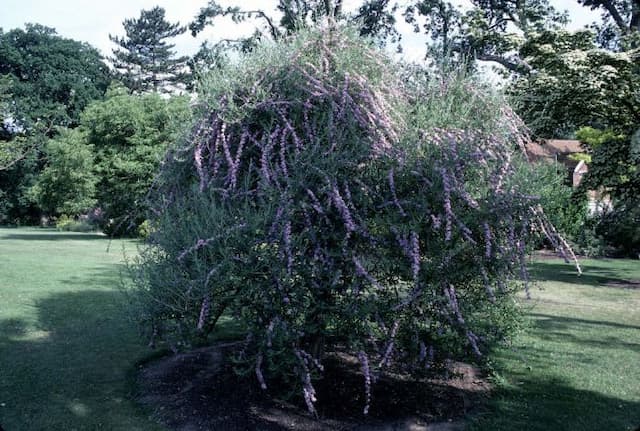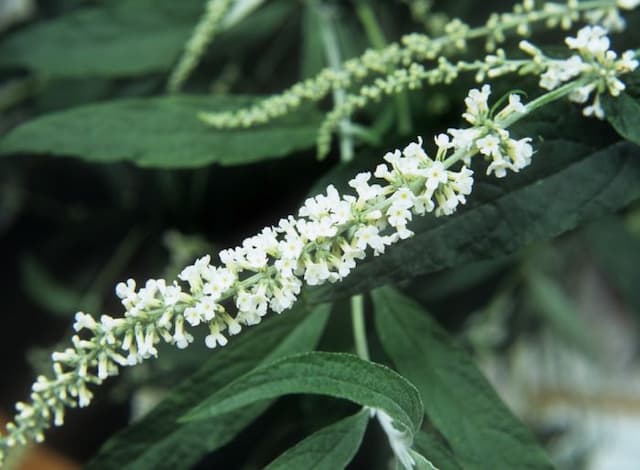Mullein Verbascum 'Clementine'

ABOUT
The plant known as Clementine is a striking perennial with a robust structure. It distinguishes itself through its attractive foliage and eye-catching blossoms. The leaves are characterized by a soft, silvery-green hue and are often covered with fine hairs, giving them a velvety texture. The foliage forms a rosette at the base which is both lush and dense. What truly sets the Clementine apart, though, are its flowers. The blossoms come in a warm, orangey peach shade that adds a vibrant pop of color to any garden. These flowers are arranged densely on a tall, upright spike, forming a substantial inflorescence that blooms over an extended period of time. Each individual flower is cup-shaped, comprising five rounded petals that are somewhat crinkly in texture, exuding a subtle, rustic charm. The aesthetic of the plant is further enhanced by the stamens, which often feature prominent, contrasting colors, such as purple or brown, that stand out against the softer tones of the petals. This combination of the flowers' color, shape, and arrangement makes the Clementine an ornamental feature that is capable of capturing the gaze of any onlooker, providing a delightful spectacle throughout its flowering phase.
About this plant
 Names
NamesFamily
Scrophulariaceae.
Synonyms
Mullein, Velvet Plant.
Common names
Verbascum 'Clementine'.
 Toxicity
ToxicityTo humans
Verbascum 'Clementine', commonly known as Mullein, is not known to be toxic to humans. There are no widespread reports or scientific literature that indicate toxicity resulting from ingesting parts of this plant. However, it is always advisable to avoid consuming plants not known to be edible and to consult a medical professional if ingestion occurs and any adverse symptoms are experienced.
To pets
Mullein is not known to be toxic to pets. There is no substantial evidence to suggest that ingestion of Verbascum 'Clementine' by pets causes poisoning or adverse health effects. Nevertheless, pet owners should always monitor their animals for any unusual behavior or signs of illness after ingesting plant material and consult a veterinarian if they have concerns. It's important to discourage pets from eating ornamental plants as a general precaution.
 Characteristics
CharacteristicsLife cycle
Biennials
Foliage type
Deciduous
Color of leaves
Green
Flower color
Orange
Height
2 feet 11 inches [90 cm]
Spread
1 foot 8 inches [50 cm]
Plant type
Herb
Hardiness zones
5
Native area
Europe
Benefits
 General Benefits
General Benefits- Attracts Pollinators: Verbascum 'Clementine' is known to attract bees, butterflies, and other beneficial insects to the garden.
- Drought Tolerant: Once established, it is drought resistant, making it a smart choice for water-wise gardens.
- Low Maintenance: Requires minimal care beyond initial planting and occasional watering, suitable for gardeners of all levels.
- Decorative Flowers: Boasts attractive orange flowers that can add a splash of color to the landscape.
- Long Blooming Period: Flowers from early to late summer, providing long-lasting visual interest.
- Cold Hardy: Can withstand cold temperatures, making it suitable for a variety of climates.
- Deer Resistant: Less likely to be eaten by deer, a benefit in areas where deer are a common garden pest.
- Architectural Structure: Adds height and structure to borders and flower beds with its tall flower spikes.
- Versatility: Can be used in cottage gardens, borders, gravel gardens, or as a cut flower in arrangements.
- Fast Growing: Rapid growth rate that allows gardeners to quickly establish the plant and enjoy its benefits.
 Medical Properties
Medical Properties- This plant is not used for medical purposes.
 Air-purifying Qualities
Air-purifying QualitiesThis plant is not specifically known for air purifying qualities.
 Other Uses
Other Uses- Mullein 'Clementine' can be used as a coloring agent, with its flowers having the potential to produce a natural yellow to green dye for fabrics.
- The stalks of Mullein 'Clementine' may be dried and used in floral arrangements for their unique structure and height.
- The leaves of the plant can be used to create a natural fish poison, traditionally used in some cultures to stun fish for easy capture without harming the ecosystem.
- Mullein 'Clementine' can serve as a torch when dried and dipped in wax or fat, thanks to its tall and sturdy flower spikes.
- The soft leaves of Mullein 'Clementine' have traditionally been used as a natural toilet paper substitute in the wilderness.
- The seeds of the Mullein 'Clementine' have been used to create a simple, eco-friendly lubricant for the maintenance of garden tools.
- When planted, Mullein 'Clementine' can act as a trap crop for pests such as thrips, thereby protecting nearby more valuable plants in a garden.
- The woolly leaves are sometimes used as liners for shoes or gloves to provide insulation and comfort due to their soft texture.
- The dense foliage of Mullein 'Clementine' can provide a protective cover for small wildlife, creating mini-habitats within a garden setting.
- Mullein 'Clementine' ashes, post combustion, can be mixed with soap solutions to enhance cleaning properties for metal surfaces.
Interesting Facts
 Feng Shui
Feng ShuiThe mullein is not used in Feng Shui practice.
 Zodiac Sign Compitability
Zodiac Sign CompitabilityThe mullein is not used in astrology practice.
 Plant Symbolism
Plant Symbolism- Healing - Verbascum, commonly known as Mullein, has traditionally been used in herbal remedies for its anti-inflammatory and soothing properties.
- Protection - The thick, wooly leaves of Mullein have been associated with providing protection and comfort, symbolizing a shield against harm.
- Love Divination - In some folk traditions, Mullein was used in rituals to predict the future of relationships, making it a symbol of love divination.
- Courage - Mullein's towering flower stalks, which stand tall and resilient, can represent courage and the ability to stand firm despite adversity.
 Water
WaterThe Mullein 'Clementine' prefers a moderate amount of water. During the growing season, water the plant thoroughly once a week, allowing the soil to dry out slightly between waterings. Each watering should provide enough water to saturate the soil to a depth of several inches, which typically translates to about 1 gallon for an established plant in the ground. Reduce water frequency in the winter when the plant is dormant, watering lightly every few weeks just to prevent the soil from becoming bone dry.
 Light
LightThe Mullein 'Clementine' thrives best in full sunlight. It should be placed or planted in a location where it can receive at least six hours of direct sunlight per day. Avoiding too much shade is crucial for the growth and blooming of this plant. The ideal spot would be in a garden bed or border that is exposed to the sun for the majority of the day.
 Temperature
TemperatureThe Mullein 'Clementine' can survive in temperatures ranging from around 20 degrees Fahrenheit to well over 90 degrees Fahrenheit. The ideal temperature range for this plant to thrive is between 60 and 80 degrees Fahrenheit. It is fairly cold-hardy and can tolerate light frosts, but prolonged exposure to temperatures below 20 degrees Fahrenheit may damage the plant.
 Pruning
PruningPruning Mullein 'Clementine' should be done to maintain its shape and remove spent flower spikes to encourage more blooms. Prune in the late winter or early spring before new growth begins. Deadheading, or removing old flower stalks, can be done throughout the blooming season. The best time to prune heavily, if necessary, is after the last frost in spring.
 Cleaning
CleaningAs needed
 Soil
SoilMullein 'Clementine' prefers a well-draining soil mix with a slightly alkaline pH, around 6.5 to 7.5. A mixture of loamy garden soil, sand, and a small amount of compost or aged manure will encourage healthy growth. Good drainage is crucial to prevent root rot, so consider adding perlite or gravel if you have heavy clay soil.
 Repotting
RepottingMullein 'Clementine' doesn't need frequent repotting and can be repotted every 2-3 years or when it outgrows its current container. Spring is the best time to repot, allowing the plant to establish in the growing season.
 Humidity & Misting
Humidity & MistingMullein 'Clementine' is tolerant of a wide range of humidity levels and does not require high humidity to thrive. It's well-adapted to outdoor conditions in most climates and does not have specific humidity needs when grown indoors.
 Suitable locations
Suitable locationsIndoor
Place in bright, indirect light and well-draining soil.
Outdoor
Full sun to partial shade, well-draining soil, protect from harsh winds.
Hardiness zone
5-9 USDA
 Life cycle
Life cycleVerbascum 'Clementine', also known as Mullein 'Clementine', begins its life cycle as seeds that germinate in the spring when soil temperatures warm up. Once germination occurs, seedlings develop into rosettes of foliage during their first growing season. In the following year, the rosette gives rise to a tall flowering stem that can reach up to 1-2m in height, blooming with clusters of yellow to orangey-peach flowers in the early to mid-summer. After flowering, the plant produces capsules that contain numerous small seeds, completing its reproductive cycle. Mullein 'Clementine' is a biennial plant, meaning it typically lives for two years, with the second year devoted to flowering and seed production before the plant dies. However, it can self-seed readily, ensuring the continuous presence of the plant in the garden.
 Propogation
PropogationPropogation time
Early Spring
Verbascum 'Clementine', commonly known as Mullein, is typically propagated by seed. The best time to sow seeds is in late winter to early spring, just before the last frost date. Sowing can be done directly into the ground or in seed trays filled with a well-draining soil mix. Lightly press the seeds into the soil but do not cover them, as they require light for germination. Keep the soil evenly moist until germination, which usually takes about 2 to 3 weeks. Seedlings can then be transplanted outdoors after they have developed a few true leaves and when all danger of frost has passed. It's important to space the plants about 18 inches (approximately 45 centimeters) apart to allow for their tall growth and broad foliage.




![Butterfly bush [Florence]](/_next/image?url=https%3A%2F%2Fplants-admin.emdemapps.com%2Fimages%2Fplants%2F%2Fimages%2F604b5f52d7bb1.png&w=640&q=75)




